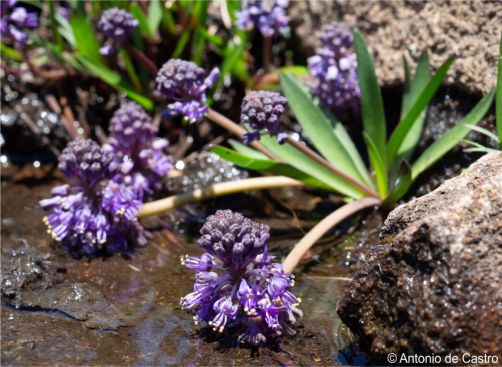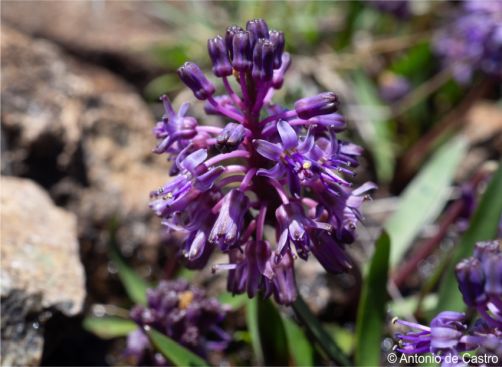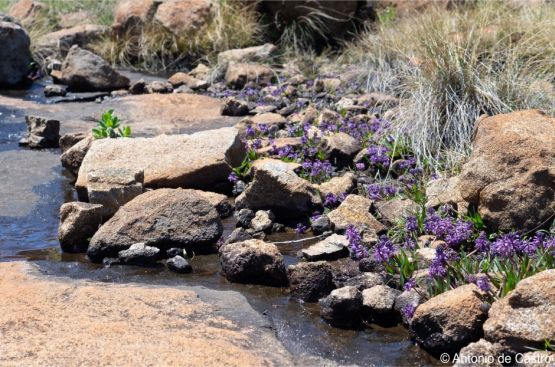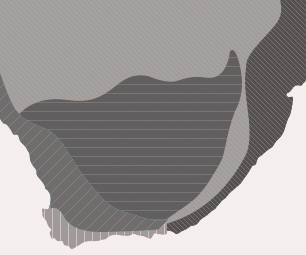Ledebouria noritica
Ledebouria noritica Hankey & Ant.Castro
Family: Hyacinthaceae
Common names: norite African hyacinth
Introduction
Dwarf bulbous plant with narrow, glossy, dark green leaves and rich purple-blue flowers in early summer.

Fig. 1. Ledebouria noritica growing near water, Steenkampsberg, Mpumalanga.
Description
Description
Dwarf deciduous bulbous plant with narrowly lanceolate, glossy green leaves occurring in densely packed mats (rarely solitary) comprised of many tightly packed individuals proliferating from seed and bulbils which develop at the base of the parent bulb. The deciduous leaves are produced in summer and may be spreading to somewhat erect, dark glossy green often with a purplish coloration basally. The flower stalk emerges in early summer, together with the leaves, topped with deep purple-blueish flowers, followed by the development of green seed capsules which shrivel to reveal the rich brown wrinkled seeds, which are dropped around the base of the mother plants and spread by the shallow flowing water which characterizes the habitat.

Fig. 2. Ledebouria noritica has rich purple-blue flowers.
Conservation Status
Status
Ledebouria noritica has not been formerly assessed for the Red List of South African Plants, however the authors of the species proposed that it may qualify for Endangered (EN) under the IUCN 2012 red list categories, due to the highly restricted range of the species.
Distribution and habitat
Distribution description
This species is regarded as a narrow endemic, known from only a few collections in the Mpumalanga and Limpopo provinces, straddling the provincial border. Ledebouria noritica is restricted to seasonally or temporarily saturated, shallow skeletal, gravelly soils overlying norite (an igneous rock type) sheetrock habitat in montane grassland. The plants congregate and the edges of shallow soil and rocks overlaying rock sheets which are wet or flowing due to seasonal surface seepage. The soil in these habitats is wet throughout the summer rainy season, and dries out completely during the cold winter months when the plants are dormant.
The habitat of this species experiences moderate rainfall (±800 mm pa.), mostly during the summer months, with little to no rain in the very cold, dry winter season. The species is completely dormant in winter when the temperatures can reach freezing or slightly below and frost may be frequent.

Fig. 3. Ledebouria noritica growing among rocks and gravel on the edges of Norite outcrops, Steenkampsberg, Mpumalanga.
Derivation of name and historical aspects
History
The species was named in 2024 after being discovered by Mr. Antonio de Castro a few years earlier, while conducting scientific surveys in the area on behalf of the landowner. The species name noritica is in reference to the specific rock type, norite, where the plant was discovered and, as far as is currently known, the species only occurs on this specific geology. The genus Ledebouria is named after a German-Estonian botanist, Professor Carl Friedrich von Ledebour (1785–1851).
The centre of diversity for the genus is over the eastern parts of South Africa, most notably in the Mpumalanga province. However the genus occurs from the Cape of South Africa across southern Africa stretching mostly up the eastern side of the continent into India, with one species each on the islands of Socotra and Madagascar.

Fig. 4. Ledebouria noritica grows in seasonally wet or damp seepage areas, Steenkampsberg, Mpumalanga.
Ecology
Ecology
Hankey & De Castro (2024) suggested that current knowledge of this species indicates that it is restricted in its range by altitude. This species has so far only been recorded occurring between the altitudes of 1 760 to 1 920 m.a.s.l.
The species is open pollinated, meaning it is pollinated by many visiting insects. The tiny dark brown and wrinkled seeds are produced quickly after the flowers and are released around the base of the mother plant. Venter (1993) conducted research on other Ledebouria species suggesting that the seeds are spread by water wash.
Uses
Use
There are no known or recorded medicinal or cultural uses of this species.
Growing Ledebouria noritica
Grow
This species is easily maintained in cultivation. It prefers a cool climate and can be planted in a loamy soil mixture with the addition of sifted well-rotted leaf litter or compost and kept in full sun. Watering should be done in summer and can be frequent. In winter the plants should be allowed to dry out completely until the leaves shrivel entirely. Light watering can then be applied once every two to three weeks during the dormant season, just to maintain soil humidity. Ideally the plants should not be lifted during the dormant season, but rather just moved out of the rain. Plants respond well to feeding with organic and inorganic fertilisers.
Propagation is best achieved through seed or division of the bulbs, the species usually proliferates very quickly and will soon fill the pot. Sow the seed as soon as it is produced and still fresh, in a sifted mixture of fine-milled bark based seedling mix with fine sand and finely sifted compost mixed in equal parts, the addition of organic fertilizer can be beneficial, or it can be added after germination once the seedlings have established their first leaf. A general fungicide should be applied to prevent damping off. The seedlings can be transplanted once they are large enough to handle or left until the second growth season.
Plants are susceptible to slugs and snails in cultivation, counter measures can be applied if these pests are noticed to be causing damage to the plants. Mealy bug can be a problem in the crown, or under the leaves, or on the roots, especially if air circulation is poor or plants are kept in confined spaced such as greenhouses or indoors.
References
- Dictionary of botanical epithets. http://www.winternet.com/~chuckg/dictionary.html
- Hankey, A.J. & De Castro, A. 2024. Four new species of Ledebouria Roth. (Hyacinthaceae) from the high altitude grasslands of the Steenkampsberg, South Africa. Haseltonia 31(1):103–126.
- Jessop, J.P. 1970. Studies in the bulbous Liliaceae in South Africa: 1. Scilla, Schizocarpus and Ledebouria. Journal of South African Botany 36(4): 233–266.
- Venter, S. 1993. A revision of the genus Ledebouria Roth (Hyacinthaceae) in South Africa. Unpublished M.Sc. thesis, University of Natal, Pietermaritzburg.
- Venter, S. 2008. Synopsis of the genus Ledebouria Roth (Hyacinthaceae) in South Africa. Herbertia 62
Credits
Andrew Hankey
Walter Sisulu National Botanical Garden
November 2025
Acknowledgements: images by Antonio de Castro
Plant Attributes:
Plant Type: Bulb
SA Distribution: Limpopo, Mpumalanga
Soil type: Loam
Flowering season: Spring, Early Summer
PH: Alkaline, Neutral
Flower colour: Blue, Purple
Aspect: Full Sun
Gardening skill: Easy
Special Features:
Horticultural zones









Rate this article
Article well written and informative
Rate this plant
Is this an interesting plant?
Login to add your Comment
Back to topNot registered yet? Click here to register.